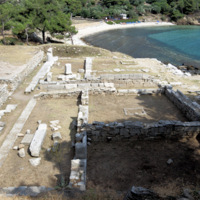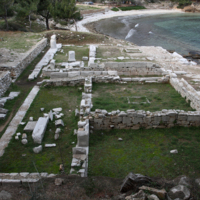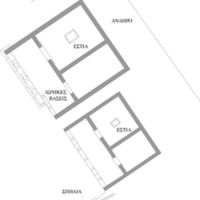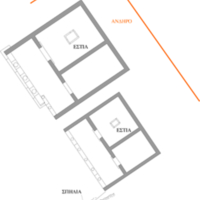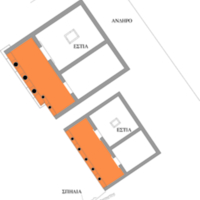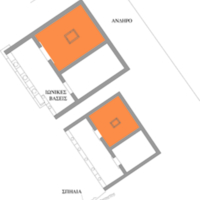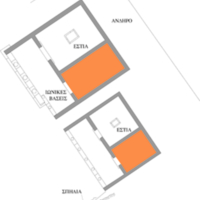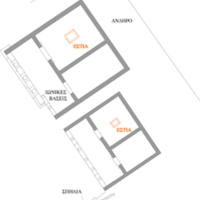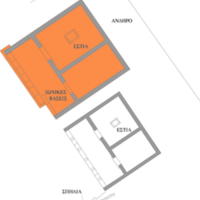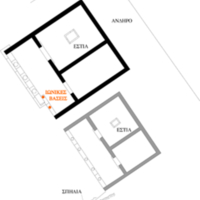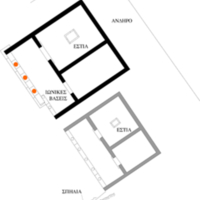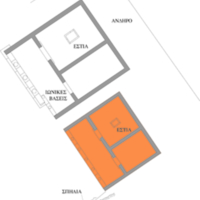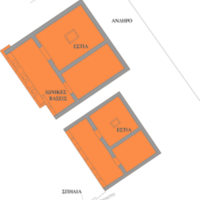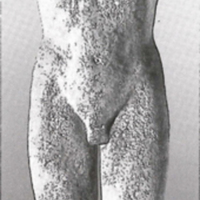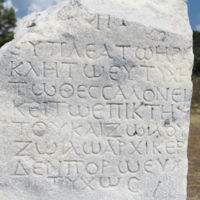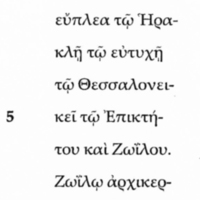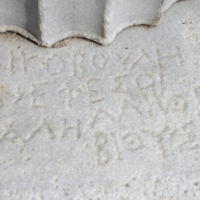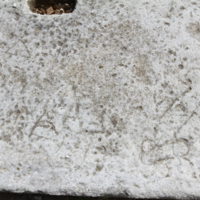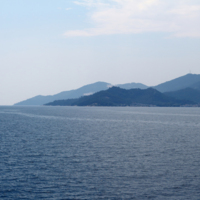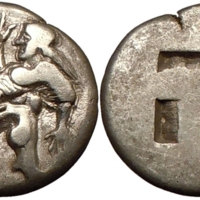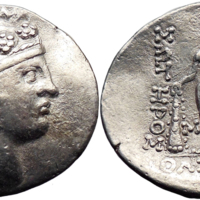The ancient sanctuary (also called "The Sanctuary of Dioscouri")
Dublin Core
Title
The ancient sanctuary (also called "The Sanctuary of Dioscouri")
Language
en
Identifier
ALK.04
Is Part Of
POI Item Type Metadata
Latitude
40.60481
Longitude
24.74257
WebContent
The ancient sanctuary (also called "The Sanctuary of Dioscouri")
Ruins of two buildings in the ancient sanctuary, which was probably dedicated to Apollo. The sanctuary was founded shortly after the arrival of the Parians at Thassos, in the mid-7th century BC, and it had continuous religious activities all the way up to the end of the worship of the ancient gods. Within the sanctuary, there are many inscriptions and carvings on several architectural parts of buildings, but also on marble bases, which were found. In one of these bases there is an inscription with prayers to the "Gods Saviors ", in other words to Dioskouri.
According to the Greek mythology Dioskouri, Castor and Polydefkis, were twin brothers, sons of Zeus and Lyda and brothers of Helen of Sparta. They are considered to be protectors of sailors since they appear as constellations in order to help sailing. They are directly connected with the sanctuary of the Great Gods of Samothrace and the famous Kaviria Mysteries. The find of the inscription and the existence of two buildings with identical floor plan, led to the wrong assumption that the place was a sanctuary dedicated to the twin sons of Zeus, Dioskouri.
Excavations revealed a surface, with overall dimensions of approximately 30 x 17 meters, which is occupied by two buildings with identical floor plans, but with one building to be slightly larger than the other.
For the construction of buildings, the area was leveled and smoothed, while marble blocks were used in order to create a terrace.
The buildings which were constructed for the operational needs of the sanctuary, have a portico with five columns and behind it there are two apartments.
The northern apartment of each building is slightly larger than the equivalent southern apartment, of each building.
The northern apartment of each building has a hearth made of marble bricks.
The oldest archaeological layer in the north building, is dated on the mid-7th century BC. However, the building got the form it has today, during the period between 530 BC and the 3rd century AD.
From approximately 470 to 465 BC, the Ionic columns of the portico of the northern building started to get replaced by Doric columns instead. This replacement was never completed.
The smaller, southern construction was built between 500 and 470-465 BC.
Both buildings were abandoned in the 3rd century AD. The buildings were serving as utility rooms where all the religious people gather, in order to host the symposiums, which followed the sacrifices and prayers for good navigation of the sailors who were transferring the marbles of the quarry.
The excavations of the northern building took place in 1887 by Theodore Bent, and brought to light this archaic kouros, which today is located at the Archaeological Museum of Istanbul. The archaic kouros, is a typical representation of Thassian archaic sculpture which demonstrates the sovereignty of the artistic standards of Paros, which was the metropolis of the colony of Thassos.
Inscribed base shaped altar, of the late Roman period (second-third century AD)
A.1
ῃ
εὔπλε ῷ Ἡρ - κλ ῷ εὐ υ
ῷ Θεσσ λονει-
5 κεῖ ῷ Ἐπικ ή- ου κ ὶ Ζωΐλου.
Ζωΐλῳ ρ ικερ- δενπόρῳ εὐ- υ ῶς.
The translation of the inscription is approximately the one follows:
Good Luck!
Wishes for a good journey to the lucky Hercules from Thessaloniki, a ship which belongs to Epiktitos and Zoilos, and also good luck to Zoilos, the great merchant, called “archikerdemporos”.
Archikerdemporos was probably the name of the title of the head of a group or a trade union of merchants. In other signs the term “nafkliros” is displayed instead.
In the north building, the sanctuary of Dioscuri as it is called, and on the pillar of the portico with the Doric columns, there are carvings preserved which are dated since antiquity. In these inscriptions, carved out probably by visitors of the sanctuary, we can read the names of the latter and also perhaps the names of their partners as well. So in the picture shown, we could read the following:
NIKOBULE
OF EPHESUS
GOOD TRUTH
VITHYS GOOD
In another part of the pillar, symbols are inscribed on the marble, which could probably reveal the sexual orientation of the visitors of the site!
The first Greek colonists, who arrived on the island in the early 7th BC century, are Parians who settled after going through hard battles with the local Thracian tribes on the north side of the island, where the port is today, where they discovered the ruins of the ancient city of Thassos. It is likely that Parians chose Thassos due to the potential to extract gold, as well as silver, lead, copper and iron, but also because of the quarrying of marble, and also because of the precious and plentiful timber, which fed all the local shipyards in order to build the fleet which was promoting the products of the island, including the famous, Thassian wine throughout the ancient Greek world. The exploitation of the marble quarries, as well as the gold and silver mines of the inland of Thrace brought during ancient times,a great economic growth and prosperity throughout the island.
Thassos developed its own coinage and its coins circulated widely in the ancient world. On the front side of the coins there is a representation of themes related to the worship of Dionysus: either the god of wine himself, or his followers Satyrs and Maenads. On the back side, and also depending on the historical period, there are representation of dolphins, craters, concave squares, or even Hercules.
A silver Stater of Thassos of the Classical Age: A representation of a typical Dionysian scene of a Silenus who grabs a resisting Mainada, the resistance of the latter is indicated by her right hand which is raised with an open palm. This is dated back to the 5th century BC (around 463-411 BC), it has diameter of 21 mm and its weight is 8.66 grams. On the back side, a concave square appears.
A silver four drachma coin of Thassos of the Roman Age: It pictures the head of the young Dionysus crowned with ivy. This is dated back to the 2nd century BC (after 148 BC) and it has diameter of 30 mm and its weight is 16.92 grams. On the back side there is an illustration of: Hercules with lion skin and a bat and there is an inscription which says "HERCULES SAVIOR OF THE THASSIANS". This specific coin, as well as a coin of Maronia dated on the same period, are the most important in the region.
Ruins of two buildings in the ancient sanctuary, which was probably dedicated to Apollo. The sanctuary was founded shortly after the arrival of the Parians at Thassos, in the mid-7th century BC, and it had continuous religious activities all the way up to the end of the worship of the ancient gods. Within the sanctuary, there are many inscriptions and carvings on several architectural parts of buildings, but also on marble bases, which were found. In one of these bases there is an inscription with prayers to the "Gods Saviors ", in other words to Dioskouri.
According to the Greek mythology Dioskouri, Castor and Polydefkis, were twin brothers, sons of Zeus and Lyda and brothers of Helen of Sparta. They are considered to be protectors of sailors since they appear as constellations in order to help sailing. They are directly connected with the sanctuary of the Great Gods of Samothrace and the famous Kaviria Mysteries. The find of the inscription and the existence of two buildings with identical floor plan, led to the wrong assumption that the place was a sanctuary dedicated to the twin sons of Zeus, Dioskouri.
Excavations revealed a surface, with overall dimensions of approximately 30 x 17 meters, which is occupied by two buildings with identical floor plans, but with one building to be slightly larger than the other.
For the construction of buildings, the area was leveled and smoothed, while marble blocks were used in order to create a terrace.
The buildings which were constructed for the operational needs of the sanctuary, have a portico with five columns and behind it there are two apartments.
The northern apartment of each building is slightly larger than the equivalent southern apartment, of each building.
The northern apartment of each building has a hearth made of marble bricks.
The oldest archaeological layer in the north building, is dated on the mid-7th century BC. However, the building got the form it has today, during the period between 530 BC and the 3rd century AD.
From approximately 470 to 465 BC, the Ionic columns of the portico of the northern building started to get replaced by Doric columns instead. This replacement was never completed.
The smaller, southern construction was built between 500 and 470-465 BC.
Both buildings were abandoned in the 3rd century AD. The buildings were serving as utility rooms where all the religious people gather, in order to host the symposiums, which followed the sacrifices and prayers for good navigation of the sailors who were transferring the marbles of the quarry.
The excavations of the northern building took place in 1887 by Theodore Bent, and brought to light this archaic kouros, which today is located at the Archaeological Museum of Istanbul. The archaic kouros, is a typical representation of Thassian archaic sculpture which demonstrates the sovereignty of the artistic standards of Paros, which was the metropolis of the colony of Thassos.
Inscribed base shaped altar, of the late Roman period (second-third century AD)
A.1
ῃ
εὔπλε ῷ Ἡρ - κλ ῷ εὐ υ
ῷ Θεσσ λονει-
5 κεῖ ῷ Ἐπικ ή- ου κ ὶ Ζωΐλου.
Ζωΐλῳ ρ ικερ- δενπόρῳ εὐ- υ ῶς.
The translation of the inscription is approximately the one follows:
Good Luck!
Wishes for a good journey to the lucky Hercules from Thessaloniki, a ship which belongs to Epiktitos and Zoilos, and also good luck to Zoilos, the great merchant, called “archikerdemporos”.
Archikerdemporos was probably the name of the title of the head of a group or a trade union of merchants. In other signs the term “nafkliros” is displayed instead.
In the north building, the sanctuary of Dioscuri as it is called, and on the pillar of the portico with the Doric columns, there are carvings preserved which are dated since antiquity. In these inscriptions, carved out probably by visitors of the sanctuary, we can read the names of the latter and also perhaps the names of their partners as well. So in the picture shown, we could read the following:
NIKOBULE
OF EPHESUS
GOOD TRUTH
VITHYS GOOD
In another part of the pillar, symbols are inscribed on the marble, which could probably reveal the sexual orientation of the visitors of the site!
The first Greek colonists, who arrived on the island in the early 7th BC century, are Parians who settled after going through hard battles with the local Thracian tribes on the north side of the island, where the port is today, where they discovered the ruins of the ancient city of Thassos. It is likely that Parians chose Thassos due to the potential to extract gold, as well as silver, lead, copper and iron, but also because of the quarrying of marble, and also because of the precious and plentiful timber, which fed all the local shipyards in order to build the fleet which was promoting the products of the island, including the famous, Thassian wine throughout the ancient Greek world. The exploitation of the marble quarries, as well as the gold and silver mines of the inland of Thrace brought during ancient times,a great economic growth and prosperity throughout the island.
Thassos developed its own coinage and its coins circulated widely in the ancient world. On the front side of the coins there is a representation of themes related to the worship of Dionysus: either the god of wine himself, or his followers Satyrs and Maenads. On the back side, and also depending on the historical period, there are representation of dolphins, craters, concave squares, or even Hercules.
A silver Stater of Thassos of the Classical Age: A representation of a typical Dionysian scene of a Silenus who grabs a resisting Mainada, the resistance of the latter is indicated by her right hand which is raised with an open palm. This is dated back to the 5th century BC (around 463-411 BC), it has diameter of 21 mm and its weight is 8.66 grams. On the back side, a concave square appears.
A silver four drachma coin of Thassos of the Roman Age: It pictures the head of the young Dionysus crowned with ivy. This is dated back to the 2nd century BC (after 148 BC) and it has diameter of 30 mm and its weight is 16.92 grams. On the back side there is an illustration of: Hercules with lion skin and a bat and there is an inscription which says "HERCULES SAVIOR OF THE THASSIANS". This specific coin, as well as a coin of Maronia dated on the same period, are the most important in the region.
Entrance
WikipediaLink
https://en.wikipedia.org/wiki/Thasos
WikipediaContent
Thasos or Thassos (Greek: Θάσος) is a Greek island in the northern Aegean Sea, close to the coast of Thrace and the plain of the river Nestos but geographically part of Macedonia. It is the northernmost Greek island, and 12th largest by area. Thasos is also the name of the largest town of the island (also known as Limenas Thasou, "Harbour of Thasos"), situated at the northern side, opposite the mainland and about 10 kilometres (6 mi) from Keramoti. Thassos island is a known from the ancient times for its termae making it a climatic and balneoclimateric resort area.
Files
Collection
Citation
“The ancient sanctuary (also called "The Sanctuary of Dioscouri") ,” iGuide Repo, accessed December 15, 2025, http://ubuntu01.ceti.gr/omeka/items/show/1638.

